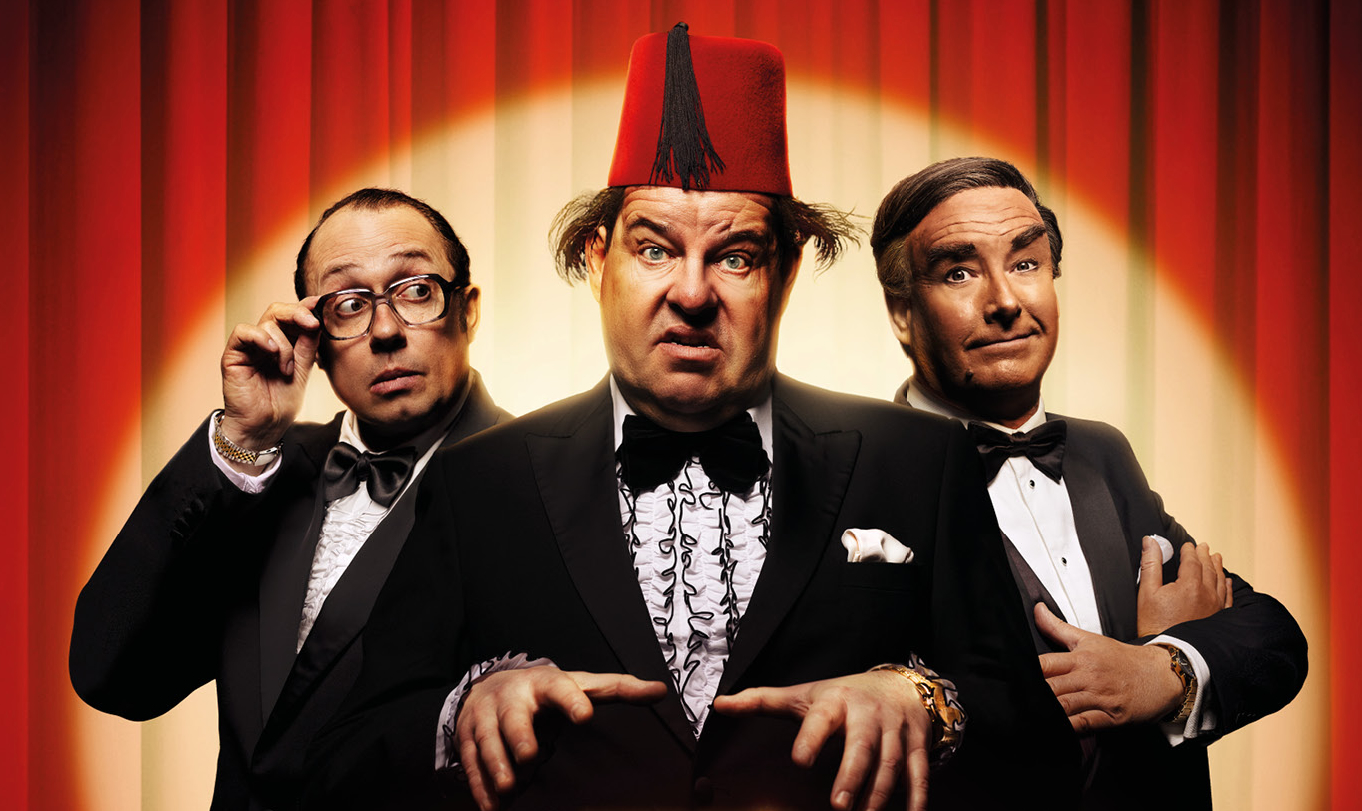THE LAST LAUGH
Written and Directed by Paul Hendy
Brits off Broadway festival at
59E59
Reviewed by David Spencer
Take three mid-20th century British standup comedians of three very different stripes: Tommy Cooper, a big man in a red fez, among whose gimmicks was magic tricks that don’t work, or don’t work as you’d expect; funny simply showing up. Eric Morecambe, an elfin sprite, most famously known for sketch comedy (with partner Ernie Wise), funny because he’s inexhaustibly energetic and inventive. And Bob Monkhouse—extremely capable of off-the-cuff riffing, as his being a game show host, that for which he became most famous, amply demonstrated; but also a sly monologist, his material finely honed, master of the quiet reversal. All three, dead. Cooper died onstage (63), Morecambe collapsing just offstage after several encores (58), both heart attacks; and Monkhouse outlasting them into the beginning of the new millennium, prostate cancer at 75.
Now take three contemporary, legit British stage-and-film actors, each of whom has, notched on his resume, a one-man show in which he has portrayed one of those comedians: Damian Williams as Cooper, Bob Golding as Morecambe, Simon Cartwright as Monkhouse.
Add Paul Hendy, British writer-director and student of comedy, who wonders what it might be like to have the three classic comedians gather in a dressing room, pre-show, where they’ll implicitly discuss their lives implicitly while explicitly discussing and comparing their approaches to the art and craft of being funny, corrals the three contemporary actors to lend their preternaturally accurate characterizations to the new context, and creates a short, prizewinning 20-minute film called The Last Laugh, in which said gathering happens.
The film goes so well that all four sign on to take it further. Hendy expands The Last Laugh into an intermissionless 90 minute play. Which is currently the mainstage attraction at 59E59, as part of that venue’s annual Brits off Broadway festival.
There is so much historical precedent for this not to work, that precedent being the sensibility gap that often exists between British standup comedy and American standup comedy. To be sure, there have been performers whose inspired dazzle or universality of subject matter has crossed the borders easily…but where something of a national identity is concerned, the traditions of funny that speak to cultural conditioning and attitude…or to something as simple as common reference points distinguishing one of theirs from one of ours…well, there are reasons why, despite having the English language and so much popular cross-pollination in common, certain household names don’t even ping the radar, significantly or at all, across the pond. In either direction.
Not to mention that from the vantage of 2025, the expectation that a general audience would even know who the hell these guys were, let alone recognize the accuracy of portrayal, is itself pretty funny.
And yet…there’s a phenomenon playwright-teacher Jeffrey Sweet has dubbed “high context.” He talks about it in terms of dialogue that implies situations and relationships such that the audience can intuit them from details without having the facts spelled out, which allows for richer characterization, disguised exposition and the engagement of audience imagination filling in the raw data. But The Last Laugh reveals another, more layered manifestation of high context: One in which assiduous replication of styles, personae and perspectives sparking off each other, with seeming effortlessness and intimacy, so seductively draws observers in that, in not much more time than it takes to describe it, the illusion of familiarity is achieved—even if you walked in, as most Yanks will, knowing nothing of the comedians being portrayed. (As it happens, due to my my fondness for following certain aspects of popular culture outside of America, I knew well who Cooper, Morecambe and Monkhouse were—but I was surrounded by people who didn’t, were captivated, and left inspired to watch vids of the originals on YouTube.)
And yes, of course, any well-wrought dramatic writing will create its own context for the storytelling universe…but I believe this is quite different. The late British comic Bruce Forsyth was of the same generation, in a general sense the same “school,” and I all-too-vividly remember, when he brought his one-man show to Broadway in 1979, how spectacularly the poor man “died” up on that stage. And with Paul Hendy’s play as a point of reference, I have a much better insight into why that happened, other than the obvious cultural divide: Forsyth in concert was naked; working without a net, the audience completely unprepared for him. Pushing what Jeff Sweet contrastingly calls low context, which in this context was the aggressive, lonely insistence of music hall reflexes with which the audience had no connection. Whereas in The Last Laugh, we have the added ingredient of Cooper, Morecambe and Monkhouse entertaining each other. Amusing each other as fellow practitioners, appreciating fine points. Singly, any one of the actual chaps may have met the same fate as Forsyth, performing in the States (and indeed, a comedy derived from the routines of Morecambe and Wise, called The Play What I Wrote, an enormous hit in the UK, limped along for only 11 weeks on Broadway, and that only because some decent notices provided a bit of hope). But Cooper, Morecambe and Monkhouse together, interacting as colleagues…the magic of it cannot be underestimated. And shouldn’t be underappreciated.
Curiously, the short film from which the play derives delivers a similarly satisfying experience. It follows the same trajectory and hits the same points, albeit more compactly. You can see it on YouTube here:
https://www.youtube.com/watch?v=fBayCccR4No
But just as curiously, the expansion doesn’t seem like an attenuation. It’s more like: Three comics on a roll, entertaining themselves but also live; keep going as long as the laughs keep coming. It’s as if the film had burst out of the screen onto its (equally) natural habitat.
The play at 59E59 runs until May 25. Highly recommended.
